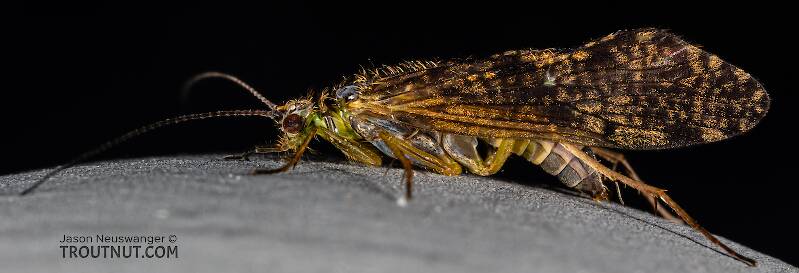
Blue-winged Olives
Baetis
Tiny Baetis mayflies are perhaps the most commonly encountered and imitated by anglers on all American trout streams due to their great abundance, widespread distribution, and trout-friendly emergence habits.
Featured on the forum

Troutnut is a project started in 2003 by salmonid ecologist Jason "Troutnut" Neuswanger to help anglers and
fly tyers unabashedly embrace the entomological side of the sport. Learn more about Troutnut or
support the project for an enhanced experience here.
Identification: Key to Genera of Rhyacophilidae Adults
Identification: Key to Genera of Rhyacophilidae Adults
Adapted from Merritt R.W., Cummins, K.W., and Berg, M.B. (2019)
This couplet refers figures (usually designated 'sf') from this source.
You will need the source (make sure to get the same edition!) to see them.
This couplet refers figures (usually designated 'sf') from this source.
You will need the source (make sure to get the same edition!) to see them.
| Option 1 | Option 2 |
|---|---|
Mesoscutellum without long hairs 
| Mesoscutellum with tuft of long, fine hairs |
| Forewings each less than 20 mm long | Forewings each more than 20 mm long |
| Widespread | Pacific states |
| Adults as in sf 10.191 | |
1 Example Specimen | |
| Rhyacophila | Himalopsyche Species Himalopsyche phryganea |
Adapted from Merritt R.W., Cummins, K.W., and Berg, M.B. (2019)
The current couplet is highlighted with darker colors and a icon, and couplets leading to this point have a icon.
Couplet 1 (You are here)
Leads to Rhyacophila:
- Mesoscutellum without long hairs
- Forewings each less than 20 mm long
- Widespread
- Adults as in sf 10.191
Leads to Himalopsyche
(Himalopsyche phryganea):
(Himalopsyche phryganea):
- Mesoscutellum with tuft of long, fine hairs
- Forewings each more than 20 mm long
- Pacific states
Start a Discussion of this Couplet
References
- Merritt R.W., Cummins, K.W., and Berg, M.B. 2019. An Introduction to the Aquatic Insects of North America (Fifth Edition). Kendall/Hunt Publishing Company.



